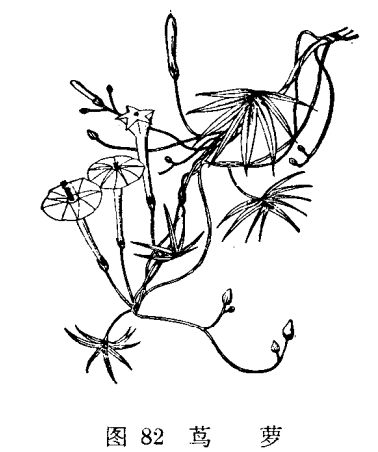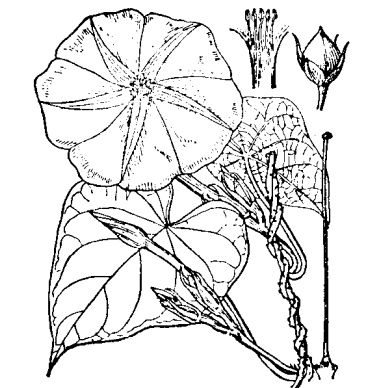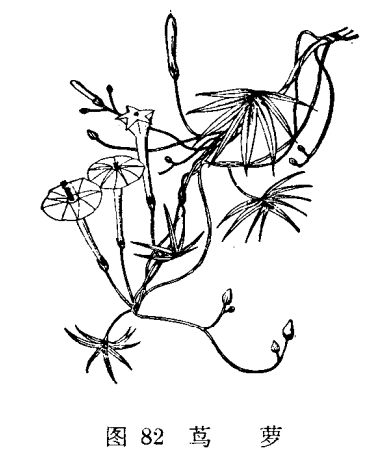How to cultivate and reproduce pineapple
[alias] feather leaf pineapple, pineapple pine, dragon flower, dragon grass, brocade screen seal.
[family genus] Convolvulaceae, genus Prunus.
[form]
Annual weak twining herbs with smooth stems up to 4 meters long. Leaves alternate, pinnatifid, 4-7 cm long, lobes striate, basal two lobes again. Cymes axillary, with several flowers. Corolla salverform, 2.5 cm long, crimson, Corolla tube slightly inflated distally, crown margin spreading, 5-lobed. Florescence from August to defrost. Capsule ovoid, seeds 4, ovoid. The weight of 1000 grains is 10.8 ~ 13.0 grams.
[varieties, forms and varieties] there are white flowers (var.alba).
[origin and distribution] originating from tropical America, it is widely cultivated in many countries.
[habit] it is not cold-resistant and can sow itself. Big seedlings are not suitable for transplantation.
[reproduction] Spring was sown in the open field seedbed at the beginning of April and sprouted unevenly. Or use a small basin on demand.

[cultivation] the seedlings grew slowly and were planted in the garden after 4 true leaves. Pot sowing seedlings can be turned into large seedlings, and then planted, the effect is better. Easy to manage. The row spacing is 30 × 60 ~ 80 cm. Respond well to fertilizer and water.
[seed collection] the capsule is irregular in maturity and can crack and scatter seeds after maturity, so it should be harvested step by step in batches.
[usage] whole herb and root can be used as medicine, clearing away heat and detumescence, treating neurasthenia, cold and fever, carbuncle swelling and toxin.
Can be used as fences, scaffolding greening materials, but also can be used to cover the surface of unattractive objects. Potted plants can be scaffolded and climbed into various shapes.
How to propagate and cultivate Prunus mandshurica
Feather leaf pineapple, famous pineapple, dragon grass and so on. The leaves are green and slender, the stems are twisted and coiled, and the potted plants can be built into frames of various shapes to make the stems and leaves grow on them. Like warmth and sunshine, not cold-resistant, self-sowing, regardless of soil.
Commonly used sowing and reproduction, suitable for spring direct seeding, not resistant to transplanting.
When potted, you can use a flowerpot with a diameter of about 15 cm □, with 3 plants planted in each pot. With the growth of seedlings, it is necessary to set up scaffolds to make them climb. During the growth period, it is advisable to reduce watering and fertilization to avoid excessive growth of stems and leaves and reduce flowering; watering should be dry and wet at ordinary times, and pay attention to spraying water to the leaves in dry weather and summer to increase air humidity. A second thin fertilizer is applied every 2 to 3 weeks in the vigorous growth season.
Pay attention to the proper thinning of vines and leaves during maintenance, which is beneficial to ventilation and light, and the plant shape is graceful. The flowering period can be prolonged if the residual flowers are picked in time after the flowers are withered, the seeds are not seeded, and the nutrients are concentrated to supply new branches to blossom.
Morphological characteristics of orange red pineapple
The stem orange red pineapple is an annual herb with twining stems, smooth and glabrous.
Leaves of orange-red pineapple are cordate, 3-5cm long and 2.5-4cm wide, cuspidate, entire, or margin polygonal, or sometimes polygonal, veins palmate; petiole slender, almost as long as leaf blade.
Flower orange red pineapple is Cymes axillary, with 3-6 flowers, total pedicel slender, longer than petiole, 2 bracts, petiole ca. 1cm, bracteoles 2; sepals 5, unequal, ovate-oblong, obtuse, with long awn tip, awn linear, long 2mm, inserted slightly below the tip of sepals; Corolla saucer-shaped, orange-red, throat yellowish, as long as 8-25mm, tube slender, abruptly spreading at throat, limb 5-parted Stamens 5, exserted outside Corolla, slightly unequal, filaments filiform, base swollen, with small scaly hairs, anthers small; pistil slightly longer than stamens; ovary 4-loculed, 1 ovule per locule; style filiform, stigma capitate, 2-lobed.
Capsule of fruit orange red pineapple small, globose, ca. 5mm, seeds 1-4, ovoid, or globose.
The flowering period of orange red pineapple is from July to September and the fruiting period is from August to October.
Ecological habits of orange red pineapple
Orange red pineapple likes to be warm, avoid cold and fear frost. It grows very slowly when the temperature is low, and the suitable temperature for seed germination is 20-25 ℃.
Orange red pineapple requires a sunny environment and is not strict with the number of hours of sunshine.
Cultivation techniques of orange red pineapple
When the small seedlings are installed in the pot or the large plants that have been raised for several years are transferred to the basin, a coarse-grained substrate with a thickness of 2-3cm is put into the bottom of the basin as a filter layer, and a layer of fully mature organic fertilizer is sprinkled on it with a thickness of about 1-2cm, then covered with a thin layer of matrix, about 1-2cm thick, and then put into the plant, and then fill the substrate to avoid root burning.
Pruning plants in winter into dormancy or semi-dormancy period, to thin, disease and insect, withered, too dense and other branches cut off. The branches can also be arranged in combination with cuttings.
When the plant grows to a certain size, consider changing a larger pot to allow it to continue to grow vigorously. The culture soil and component ratio for basin change can be selected as follows: vegetable garden soil: slag = 3RU 1; orchard soil: medium coarse river sand: sawdust (slag) = 4RU 2; or one of paddy soil, pond mud and rotten leaf soil.
Temperature and humidity management pineapple prefers a slightly humid or dry climate, requiring a relative air temperature of 50% to 70%. Like warm climate, but summer high temperature, muggy (more than 35 ℃, air relative humidity more than 80%) environment is not conducive to its growth; the winter temperature is very strict, when the ambient temperature stops growing below 10 ℃, it can not safely survive the winter under frost.
Fertilizer and water management for potted plants, in addition to adding organic fertilizer when potting, in the usual maintenance process, but also appropriate fertilizer and water management. In the peak growing season of spring, summer and autumn, fertilizer and water management circulates in the order of "Huabao"-"Huabao"-"Huabao"-clear water, with an interval period of about 1-4 days, shorter in sunny days or high temperatures, and longer or unwatered in rainy days or low temperatures. The main purpose of winter dormancy is to control fertilizer and water. Fertilizer and water management circulates in the order of "Huabao"-clear water-clear water-"Huabao"-clear water-clear water, with an interval of about 3-7 days.
The propagation mode of orange red pineapple
Sowing and breeding orange red pineapple is generally direct seeded in the open field in early spring in April. When the seedling is 10 cm high, the seedlings are planted under the courtyard fence or on both sides of the scaffolding, sparsely hanging string for its winding. If you live in a building, you can sow seeds in a shallow basin.
Cutting propagation orange red pineapple is often used for tender wood cutting in late spring and early autumn, or old branch cutting with first-year branches in early spring. When the tender wood cuttings were carried out, the sturdy branches of the current year were selected as cuttings when the plants were growing vigorously from the end of spring to early autumn. After cutting off the branches, select the sturdy parts and cut them into 5-15cm long segments, each with more than 3 leaf nodes. When cutting cuttings, it should be noted that the upper cut is flat from the upper leaf saving 1cm, the lower cutting mouth is oblique from the lowest saving 0.5cm, and the upper and lower cutting mouth should be flat (knife should be sharp). When hardwood cuttings are carried out, after the temperature rises in early spring, strong branches in the first year are selected as cuttings. Each cuttage usually retains 3-4 nodes, and the cutting method is the same as that of softwood cuttings. After cutting, cover 50% of the sunshade net. After the roots grow, remove the sunshade net at 4:00 every sunny day, and cover it before 9:00 the next day. The optimum temperature for rooting is 20-30 ℃, and the air relative humidity is 75% 85%.
Striping propagation selects the branches of strong orange red pineapple and peels off the bark from about 15-30cm below the top. The width of the peeled wound is about 1cm, and the depth is limited to just peeling off the epidermis. Cut a piece of film with a length of 10-20cm and a width of 5-8cm, put some wet garden soil on it, and wrap it up like a wound. The upper and lower ends of the film are tightly tied and bulged in the middle. It takes root after about 4-6 weeks. After taking root, cut off the root system along the edge of the branch to form a new plant.
After reading the above introduction about the cultivation and reproduction of orange-red pineapple, do you know more about the cultivation and reproduction of orange-red pineapple? if you want to know more about orange-red pineapple, please continue to pay attention.
- Prev

How to cultivate and reproduce moonlight flower
[alias] Tianjier, Chang'e rushed to the moon. [family genus] Convolvulaceae, genus Moonflower. [form] herbaceous, winding big vines, stems up to 5 to 6 meters long, with milk. Leaves alternate, ovate-cordate, or hastate, sometimes trifid, with long stalks. Cymes axillary, with 1-7 flowers. Corolla saucer-shaped, white
- Next

What are the two kinds of flowers belonging to the same genus as pineapple
1. Round leaf pineapple (Q.cocczneaMoench). Also known as orange red pineapple. Annual twining herbs, up to 4 meters long. Leaves alternate, ovate, entire, apex acute or acute, base cordate, petiole as long as leaf blade. Cymes axillary, with 3. 6 flowers. Corolla high foot dish shape
Related
- Fuxing push coffee new agricultural production and marketing class: lack of small-scale processing plants
- Jujube rice field leisure farm deep ploughing Yilan for five years to create a space for organic food and play
- Nongyu Farm-A trial of organic papaya for brave women with advanced technology
- Four points for attention in the prevention and control of diseases and insect pests of edible fungi
- How to add nutrient solution to Edible Fungi
- Is there any good way to control edible fungus mites?
- Open Inoculation Technology of Edible Fungi
- Is there any clever way to use fertilizer for edible fungus in winter?
- What agents are used to kill the pathogens of edible fungi in the mushroom shed?
- Rapid drying of Edible Fungi

